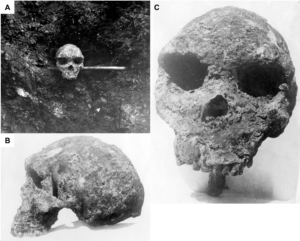Griffith University scientists have led an international team to date the skull of an early human found in Africa, potentially upending human evolution knowledge with their discovery.
The Broken Hill (Kabwe 1) skull is one of the best-preserved fossils of the early human species Homo heidelbergensis and was estimated to be about 500,000 years old.
Professor Rainer Grün from the Environmental Futures Research Institute led the team which analysed the skull and other fossil human remains found in the vicinity including a tibia and femur midshaft fragment. The material is curated at the Natural History Museum in London, where collaborators Professor Chris Stringer and Senior Curator Michael Rumsey work.

Discovered in 1921 by miners in Zambia, the Broken Hill remains have been difficult to date due to their haphazard recovery and the site being completely destroyed by quarrying.
Using radiometric dating methods, Professor Grün’s analyses now puts the skull at a relatively young date, estimating it is between 274,000 and 324,000 years old.
Publishing their findings and methodology in Nature, Professor Grün said “the new best age estimate of the fossil impacts our understanding of the tempo and mode of modern human origins.”
“The Broken Hill human fossils are now within the time range of the early Middle Stone Age, challenging assumptions that only Homo sapiens made these stone tools in Africa.”
The research also suggests that human evolution in Africa around 300,000 years ago was a much more complex process, with the co-existence of different human lineages.
Professor Stringer said: “Previously, the Broken Hill skull was viewed as part of a gradual and widespread evolutionary sequence in Africa from archaic humans to modern humans. But now it looks like the primitive species Homo naledi survived in southern Africa, H. heidelbergensis was in Central Africa, and early forms of our species existed in regions like Morocco and Ethiopia.”
Professor Grün said his team’s research adds to new and emerging studies which question the mode of modern human evolution in Africa and whether Homo heidelbergensis is a direct ancestor of our species.
